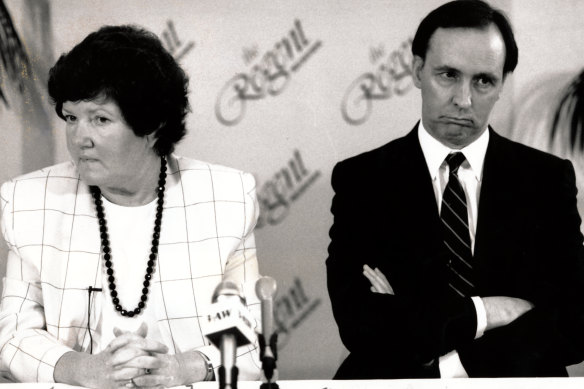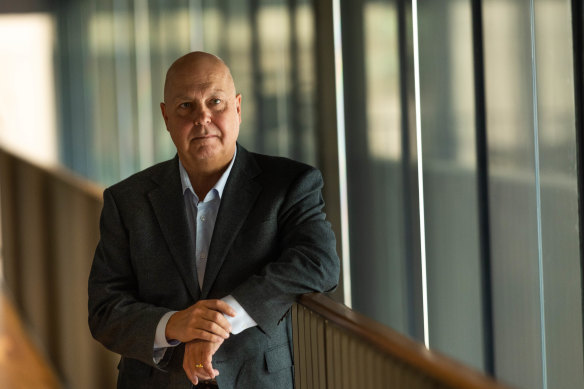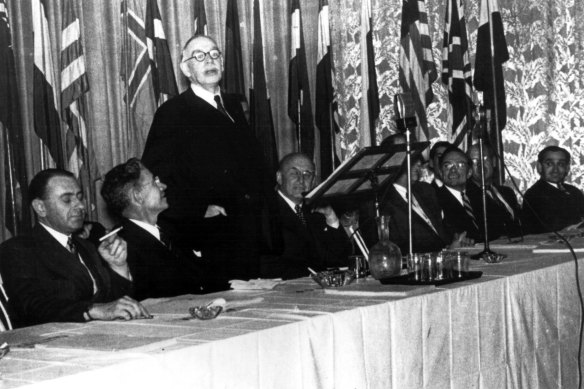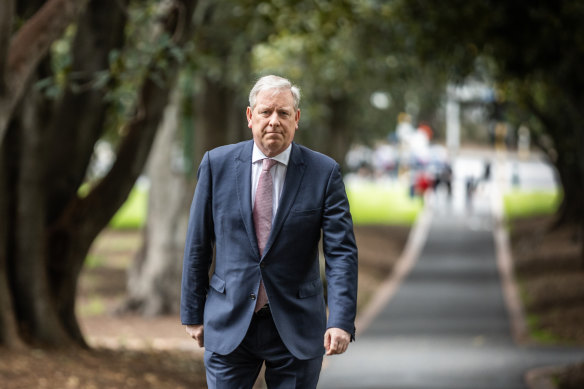‘Animal spirits’ or eaten alive: Which way is Victoria’s debt heading?
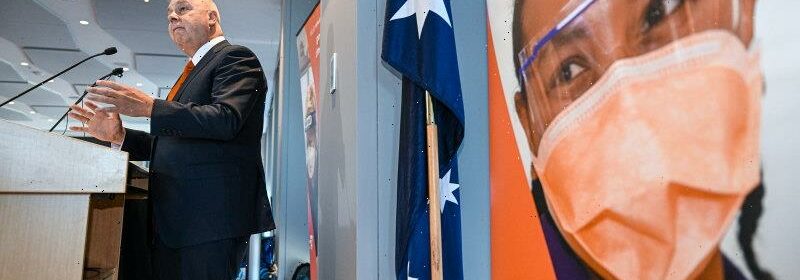
When Jeff Kennett won the October 1992 election, he inherited what might politely be described as a challenging set of numbers.
Victoria’s unemployment rate had risen extraordinarily quickly as Australia tumbled into Paul Keating’s “recession we had to have”, hitting 11.6 per cent that October with the loss of more than 140,000 jobs in just 33 months.
August 1990: Just 17 days after she became premier, Joan Kirner and federal treasurer Paul Keating announce the sale of the State Bank of Victoria.Credit:Age archive
The state had also been rocked by a series of financial scandals, including the forced sell-off of the State Bank of Victoria, which had collapsed under the burden of bad loans handed out in the 1980s by its merchant bank subsidiary, Tricontinental, and the demise of the Pyramid Building Society. Taxpayers were left to pick up the bill.
By the middle of 1992, just before Kennett was elected, Victoria’s net debt had risen to $16.2 billion, equivalent to about 15.5 per cent of the state economy. As interest rates continued to ratchet up, that year Victoria forked out about $1.8 billion to service its borrowing. This might not sound like a lot in today’s dollars, but back then it was equivalent to 12.6 per cent of the government’s total revenue. The following year the interest bill rose even higher, peaking at 13.9 per cent of revenue.
Kennett inflicted deep public sector cuts and sold off state-owned assets and focused on getting the private sector moving. The rest, as they say, is history. The scars from that period linger today, but net debt was brought back under control and the budget returned to balance.
Thirty years on from his election win, Kennett says he is now “terribly concerned” that state debt is again out of control.
In an interview with The Age this week, the former Liberal premier offered two pieces of unsolicited advice to Victoria’s Labor government: don’t commit to any more infrastructure projects until debt is back under control, and conduct a fresh commission of audit into the operation of the public sector.
“My worry, my fear, is that there’s no sign that if the current government is re-elected they are going to do anything more than continue down this path, and therefore the only way they’re going to be able to address it is to increase the charges and taxes on the community,” Kennett said.
Victoria currently has the highest debt (in proportional terms) of all the states – mostly because the Andrews government dramatically ramped up borrowing to insulate Victoria from the pandemic, but also because it has been running an ambitious big projects agenda ever since it came to power in November 2014.
But even before Labor came to power, state debt was rising. By the end of 2009-10, just before Ted Baillieu’s unexpected election win for the Coalition, net debt was equivalent to just 2.6 per cent of the state economy.
By the time the Coalition lost after just one term in 2014, state debt as a proportion of the economy had more than doubled to 5.8 per cent. In mid-2019, before the pandemic struck, it was 5.5 per cent.
According to Treasury predictions released this week, net debt is expected to rise from 20.4 per cent of gross state product by the end of this financial year, to 24.8 per cent by 2024-26, far eclipsing the peak of 16.1 per cent reached in 1992-93.
Age readers surveyed as part of our Victoria’s Agenda project have expressed concern about project mismanagement leading to cost overruns and adding to net debt projections.
But to what extent does Victoria’s debt matter? And how is the situation different now to the early 1990s? Such questions have become a focal point of the state election campaign as both sides grapple for the economic high ground.
Interest rates are once again being rapidly lifted around the world to stamp out rampant inflation. The state opposition is adamant Victoria’s borrowing will leave future generations saddled with an unacceptable financial impost, limiting the scope to spend in the future.
But in an interview with The Age this Thursday, Treasurer Tim Pallas mounted a passionate and unapologetic defence of the government’s approach, declaring its highest priority has always been to protect the well-being of the Victorian public and Victorian businesses.
The argument is that by investing in areas such as health, skills and infrastructure, the government is adding to the productive capacity of the economy. This generates jobs and business activity, which in turn adds to revenue, gradually strengthening the state’s financial position and allowing debt to be repaid.
Pallas is the first to acknowledge it is a long game.
State Treasurer Tim Pallas warned against inflicting deep spending cuts to tackle debt.Credit:Jason South
It may be far from the minds of voters struggling to pay their bills, but there are four steps to the strategy. The first was to spend to save jobs and businesses. The second was to bring the budget back to a “cash surplus”, which is when revenue outweighs spending.
The third is to get the budget back to what Treasury calls an “operating surplus”, which essentially factors in the depreciation of assets after weighing up revenue and spending. When politicians talk about surpluses or deficits (in the Victorian context), they are almost always talking about operating surpluses or deficits.
The final stage is to use the surpluses to pay back public debt (which represents the cumulative consequence of running budget deficits).
Victoria, Pallas points out, has now achieved the first two of these steps. The third step – an operating surplus – is expected to be achieved in 2025-26.
The idea is that the state will over the next decade or so grow its way clear of financial trouble, without the need for the savage spending cuts of the Kennett era.
In explaining the approach, Pallas talks about “animal spirits”, a phrase coined by the famous British economist John Maynard Keynes.
John Maynard Keynes addresses the Bretton Woods conference on postwar reconstruction in 1944.Credit:
The term, which preceded the development of behavioural economics, refers to the notion that consumer and business confidence tends to be driven by collective human emotion, particularly during periods of economic volatility or stress.
“Economics and therefore budgeting is a very complex process, but it can be boiled down to animal spirits,” Pallas says. “It’s how the market operates, whether there’s a confidence in the market, whether consumers are spending and whether businesses are confident enough to invest in growth.
“Certainly, after World War II, it was a strategy directly adopted: you grow your economy, and the consequence of that is your capacity to service the debt massively increases.”
The opposition sees things differently. It has promised an audit of all of Victoria’s major projects, and to fund health promises by shelving Labor’s Suburban Rail Loop project.
It has also announced a cap on state debt to get the state’s finances under control, although it hasn’t yet said what the cap will be, arguing it needs a clearer sense of the state’s actual financial position. It also wants to set up a Victorian Productivity Commission to focus on boosting productivity and living standards.
A key contention – one that Labor has zeroed in on for the election fight – is that going back to Kennett-era austerity would be deeply counterproductive.
“If government is sending the message to the marketplace that they’re about to review all of the major projects, which means effectively stopping or substantially retarding their capacity to continue to employ, you can take it to the bank that they’re about to slow the economy right down,” Pallas says.
Ghosts of Victoria’s past
Monash University political scientist Paul Strangio says there are two competing narratives in Victorian politics, rooted in the history of the past four decades.
On the one hand, the Coalition invokes the Cain-Kirner years and the debt and deficits of the early 1990s. On the other, Labor raises the spectre of the Kennett government, with its sweeping privatisations and cutting of state services.
“Of these two narratives, I’d suggest that the latter has more enduring and politically potent salience while the former has faded from the consciousness of the Victorian electorate,” Strangio says.
Daniel Andrews’ promise to exhume the old State Electricity Commission provides a case in point. It has presented Labor with an opportunity to remind voters of Kennett’s legacy of privatisations and public sector cuts.
“Apparently that policy has cut through again, suggesting that Kennett’s time in office continues to have the more powerful resonance and to be a handicap for the Coalition.”
Even so, the Coalition has been working hard to turn the debt blowtorch on the Labor government. With the campaign now in full swing, its political attack ads remind voters that Victoria’s debt is expected to top that of New South Wales, Queensland and Tasmania combined by 2026.
Shadow Treasurer David Davis insists Victoria’s debt levels are a problem.
In an interview with The Age this week, Davis recognises that Victoria needs to grow quickly. But he also argues cost blowouts on the government’s major projects have been unsustainable.
“This government is being eaten from within by its own rampant and uncontrolled spending on major projects,” he says.
“It is a significant issue that we face. The debt would diminish the capacity of the state to grow quickly. It would diminish the capacity of the state to spend on some of the services that it would want, and it would diminish the capacity of the state to [build] infrastructure projects we would want to undertake.”
Shadow Treasurer David Davis says Victoria’s budget has been ‘eaten from within’.Credit:Jason South
Davis also points to a recent warning from ratings agency Moody’s, suggesting spending on mega-projects could significantly erode Victoria’s spending capacity over time.
In a September update, Moody’s said that in contrast to other states, Victoria had “retained its focus on very large projects”, highlighting the flagship Suburban Rail Loop. The Parliamentary Budget Office has estimated that building the first two of the loop’s three stages will cost $125 billion.
“We expect additional large-scale unbudgeted debt-funded infrastructure will further significantly erode the state’s fiscal capacity over time,” Moody’s said.
There are, however, some important differences between the situation now and the situation in the early ’90s, as many economists have been quick to point out.
Interest rates today are far lower than they were then, making it much easier to service the debt. Even so, the interest cost of the debt is expected to rise sharply. This financial year Treasury reckons Victoria’s annual interest bill will be about $3.9 billion, equivalent to 4.7 per cent of total revenue.
But by 2025-26, the impost is expected to rise to $7.3 billion, or 7.8 per cent of total revenue, still well below the peak of 13.9 per cent in 1992-93.
Future interest rate rises have already been baked into the forecasts in the budget. State Treasury isn’t explicit about what it expects those increases to be, noting only that its assumptions follow market expectations. That suggests it has assumed the Reserve Bank’s cash rate will be lifted to between 3 and 3.5 per cent.
But there are big risks. Dig into the budget papers and they’ll tell you that if interest rates turn out to be one percentage point higher than predictions, it would add, in net terms, about $2.5 billion to state spending over four years. More than $1 billion of that would hit the budget in 2025-26, potentially wiping out the $894 million surplus expected for that year.
Pallas points out that higher interest rate rises have no impact on the substantial proportion of bonds that are already locked in at fixed rates for extended periods. The idea is that the Treasury Corporation of Victoria, which manages most of the state’s debt, smooths the impact of interest rate movements by spreading largely fixed-rate borrowings evenly over a 15-year period.
Relatively low borrowing costs – coupled with the fact that much of the borrowing has been used for productive infrastructure – has meant, unlike the early ’90s, there is no sense of crisis gripping the state. On the contrary, add in historically low state unemployment and solid economic growth and the economic outlook is generally positive.
Strangio says there are “stark differences” between today and the “powerful climate of crisis” of the early 1990s.
“Indeed, the reality is that there is no commensurate crisis,” he says.
“I’d suggest that the Andrews government has largely maintained control of the narrative around debt: they have successfully portrayed it as planned, considered policy necessary for the delivery of public infrastructure, and as unexceptional and sustainable.”
For the most part, the public appears to understand why a build-up of debt has been necessary, both in terms of providing infrastructure that will make Victoria a more liveable and productive state, and insulating people and businesses from the pandemic.
The political danger for Labor is that this perception is starting to change. There are now some significant questions emerging about whether it might be time to take a breather when it comes to mega-projects such as the $35 billion first stage of the Suburban Rail Loop.
Victoria’s public sector wages bill is now soaking up the equivalent of more than 40 per cent of total revenue, up from about 35 per cent when Labor came to power. The state is facing severe shortages of labour and building materials, likely to reach a peak just as the state is ramping up preparations for the Commonwealth Games.
But more importantly, there is now very little margin for error, and less room for new spending over the next decade or when the next crisis hits. Victoria is walking a fine line.
Brendan Coates, economic policy program director at the Grattan Institute, said the pandemic hit Victoria’s budget position especially hard as the state struggled through extended lockdowns, adding substantially to state debt.
But he suggested there could be more financial challenges on the horizon, particularly as the state’s population continues to age: “A lot of things will have to go right for the budget to return to surplus by 2025-26 as currently forecast.”
Most Viewed in Politics
From our partners
Source: Read Full Article
